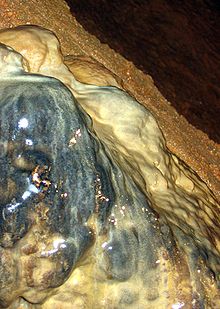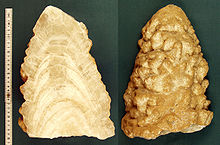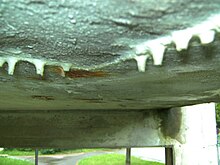Stalactite
Dripstones are generally stones that are sintered by dripping water.
Definitions
Stalactite and speleothem
In colloquial language, neither the place where they arise (cave, mine, building, etc.) nor the chemical composition is differentiated. In recent years, however, the restriction to limestone deposits and the formation in caves has become increasingly prevalent. Carbonated, flowing and, in particular, dripping water with usually very little water flow is the cause of the slow deposition of calcite . Carbon dioxide gas escapes and calcium carbonate precipitates . Stalactites are therefore related to travertine .
Recently, increasingly finds the term speleothem use, from the English speleothem is derived. However, it describes all types of secondary deposits in caves ( speleological (cave-scientific) sedimentation) and thus includes other forms in addition to stalactites.
Systematics of Speleothems

- Stalactites
- Ceiling sinter (on the cave ceiling)
- Sinter tubes (image area B - tube sinter, "macaroni")
- Stalactites (image area A )
- Ceiling sintered strips
- Sintered flags (image area F )
- Sinter curtains (image area G )
- Wall sinter (on the cave wall)
- Sinter crusts
- Sinter falls
- Canopies
- Button sinter (pearl sinter, cauliflower sinter)
- Brine sinter (in the soil area)
- Stalagmites
- Sintered walls
- Sintered ceilings
- Sinter basin (image area J )
- Wall wreaths
- Sinter terraces (image area L )
- Loose sinter molds (lying freely in the cave space)
- Cave pearls
- Calcareous membrane
- Wall sintering strips
- Others
- Stalagnate (image area E - stalactite and stalagmite that have grown together, occurring simultaneously on the cave ceiling and floor)
- Excentriques (image area H - occurring on cave wall and ceiling)
- Moon milk (image area I )
- Ceiling sinter (on the cave ceiling)
Stalactite, stalagmite or stalagnate
Depending on the arrangement of the stalactite, one speaks of stalactite , stalagmite or stalagnate , whereby the last term is used less in common parlance, as the continuous column shape is relatively rare.
Donkey bridges
- In German, the difference between the first two stalactite shapes can thereby be noted that the k of the above-hanging Stala k titen ascender has - facing upward, where the limestone attached, the g of Stala below g miten descender has - faces downward, where the stalactite is.
- Another mnemonic is: "Stalag with en have much already having made therefore m UEDE and therefore are on the ground, while Stalak t ith t ropfen and hanging from the ceiling."
- Especially for children, "The Stalak t ites come from the" T "corner, and the Stalag with en grow with you with ."
- Another award for children: "Stalak t ith hanging run t he Stalag m ites are m under!"
- A well-known donkey bridge is: "The Mi (e) ten rise and the Tit (t) en hang".
- Taking into account the shape of the capital letters “M” and “T”, “Stalag M iten” or “Stalag m iten” and “Stalak T iten” can also be good donkey bridges. The shape of the T alone is enough to remind you that the stalak t ites hang down from the ceiling.
- There is also a donkey bridge for the term stalagnate (the continuous column shape that has grown together): "If you sew two stalactites together, there is a Na (h) t ."
- In English the following saying helps: “Stala g mites g row from the g round, stala c tites c ome from the c eiling”, in French “La Stalag m ite m onte, la stalac t ite t ombe” ( monter “to rise "And tomber " fall ").
Emergence
The precipitation absorbs carbon dioxide from the atmosphere, seeps into the soil and absorbs organic acids there. This allows calcium carbonate (lime) to be dissolved in the water from the limestone. This dissolved lime combines with the carbon dioxide to form calcium hydrogen carbonate , which is easily soluble in water. When reaching a cave ceiling, this solution drips through existing crevices. When air enters, the carbon dioxide escapes and the calcium hydrogen carbonate is converted back into the poorly water-soluble calcium carbonate (lime). The water evaporates, what remains is lime, which forms stalactites over the course of thousands of years.
Chemistry and forms
As the carbonated water flows through the karst , it dissolves the limestone until it is saturated with lime . When it hits a cavity, the seepage water flows along the ceiling, loses its flow speed and forms droplets due to the surface tension . It gives off CO 2 , which leads to the precipitation of crystalline CaCO 3 . This sintered limestone forms the stalactite hanging down from the ceiling . The drop that hits the ground still contains some lime. When the drop hits, CO 2 is released again and lime precipitates. Correspondingly, another stalactite grows up from the ground and forms a stalagmite . Stalagmites and stalactites can also grow together as a column and are then called stalagnate . The evaporation of the water only takes place in a few caves or cave parts, e.g. B. at cave entrances a role. Due to the minerals dissolved in the water , stalactites can have different colors.
Dissociation equations
- Ca 2+ + 2 HCO 3 - ⇌ CaCO 3 + H 2 O + CO 2
or
- Ca 2+ + 2 HCO 3 - ⇌ CaCO 3 + H 2 CO 3
See also: Water hardness # lime-carbonic acid balance and carbonate-silicate cycle on the chemistry of sinter formation.
Dripstones made from other materials
Dripstones are not only made from lime. In the visitor mines Feengrotten in Saalfeld, Morassina in Schmiedefeld (both in Thuringia) and Alaunwerk Mühlwand in Reichenbach (Saxony) you can marvel at some colorful specimens made from Diadochite . Diadochite dripstones grow considerably faster than limestone dripstones, but they are mechanically less stable.
Icicles are created in a similar way to stalactites and can therefore develop comparable shapes.
The small, inconspicuous sintered warts in the sandstone karst, which can be observed all over the world, consist of SiO 2 .
Growth rate and stalactite age


Stalactites arise and grow very slowly on a human scale. However, the exact speed of stalactite growth varies and depends on several factors:
- Lime concentration in the water
- CO 2 content in the water and in the cave
- Amount of water dripping down
- temperature
Information about the growth rates of stalactites is very popular with cave guides . Realistic measurements of 8 to 15 millimeters per 100 years are used as a basis. However, the generalization to the entire cave and the linear extrapolation to the stalactite size is not legitimate. So a one meter long stalactite is most likely not exactly 10,000 years old.
In the Charlottenhöhle you can see a three centimeter large stalactite that grew on the lines of the historical electrical lighting. This means that the age is known (about 110 years since the line was installed) and it is possible to calculate the rate of growth. Unfortunately, the result cannot be generalized, and neighboring stalactites can also have very different growth rates. The stalactite mentioned is located under a sinkhole with humus filling and very high CO 2 and humic acid production . As a result, the growth rate is spatially very narrow, approximately fivefold.
The environmental conditions also have a decisive influence on growth. The growth rates fluctuate with climatic changes, since the four parameters given above change. The growth fluctuates very strongly in the alternation of cold and warm periods . During a cold period, the sealing of the soil due to the formation of permafrost can interrupt growth. In the last warm period it was warmer and more humid than today, so that the growth rates may have been higher. In the above example, a considerable part of the stalactite was probably formed before the last glacial period. The growth was interrupted and only continued after the end of the glacial period about 8,000 years ago. In general, the age of a stalactite is therefore used today to mean the warm period during which most of the stalactite was formed.
Finally, it should be pointed out that often only the speed of growth of “stalactites” is spoken of. It is neglected that the speed also depends on the shape. Sintered tubes can grow very quickly, but after the transition to stalactite the speed is significantly slower because the same amount of material is now deposited on a larger area. The speed of growth of the associated stalagmites again differs drastically. Any statement that does not take these differences into account has no scientific value.
However, the rate of growth is an important metric when derived from meaningful measurements. For this purpose, samples are taken and the age is determined using a suitable geophysical method for determining the age ( 14 C, U / Th or O). A meaningful growth rate can now be calculated between suitable measuring points with recognizable homogeneous growth in between. This then allows conclusions to be drawn about the climatic conditions during the formation of the stalactite.
Disruptions

The growth of the stalactites can be disturbed by cave visitors. If you touch a stalactite, fat is deposited on the skin and prevents future calcium deposits at this point.
Stalactite deposits
Basically, there are stalactites in all caves worldwide that are located in karst and limestone regions. These caves are known as stalactite caves .
Stalactites can also form on older structures when calcium hydroxide is dissolved from cement or concrete and then reacts with the carbon dioxide in the air.
Individual evidence
- ^ Schmidkonz, Wittke 2006
- ^ Illustration (photography by Jochen Duckeck), Showcaves.com
literature
- B. Schmidkonz, G. Wittke: Stalactites in time lapse . In: Chem. Our time . 40/2006, p. 246 doi : 10.1002 / ciuz.200600370 .
- B. Schmidkonz: Watch a dripstone grow . In: J. Chem. Educ. 94/2017, pp. 1492–1497 doi : 10.1021 / acs.jchemed.7b00215 . (Link to the unpublished text (unedited Authors copy), which is almost identical to the published one: https://www.researchgate.net/publication/320123945_Geochemistry_in_Action_Watch_a_Dripstone_Grow )







